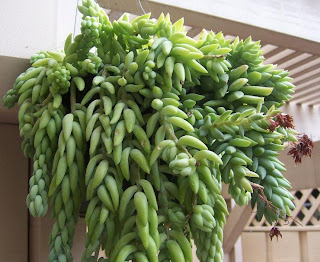It’s time to recap all the fantastic succulents we looked at this week. These plants are great for low maintenance and very drought tolerant gardens. Here they are along with links to all of my posts on these beauties.
After Glow Echeveria
Echeveria sp. ‘After Glow’
http://2minutegardener.blogspot.com/2011/09/photo-echerveria-sp-after-glow.html
Blue Chalk Fingers
Senecio vitalis
Blue Chalk Sticks
Senecio mandraliscae
http://2minutegardener.blogspot.com/2011/09/photo-blue-chalk-sticks-senecio.html
Blue Sky Echeveria
Echeveria sp. ‘Blue Sky’
http://2minutegardener.blogspot.com/2011/09/photo-echeveria-sp-blue-sky.html
Burro’s Tail
Sedum morganium
http://2minutegardener.blogspot.com/2011/09/photo-burros-tail-sedum-morganium.html
Crinkly Echeveria
Echeveria sp. ‘Crinkly’
http://2minutegardener.blogspot.com/2011/09/photo-echeveria-sp-crinkly.html
Kiwi Aeonium
Aeonium sp. ‘Kiwi’
http://2minutegardener.blogspot.com/2011/09/photo-aeonium-kiwi.html
Mediterranean Spurge
Euphorbia characias wulfenia
Mint Saucer Aeonium
Aeonium sp. ‘Mint Saucer’
http://2minutegardener.blogspot.com/2011/09/photo-aeonium-mint-saucer.html
Mother of Thousands
Kalanchoe daigremontiana
http://2minutegardener.blogspot.com/2011/09/photo-mother-of-thousands-kalanchoe.html
Paddle Plant
Kalanchoe thyrsiflora
http://2minutegardener.blogspot.com/2011/09/photo-paddle-plant-kalanchoe.html
Pork n’ Beans Sedum
Sedum rubrotinctum
http://2minutegardener.blogspot.com/2011/09/photo-pork-n-beans-sedum-sedum.html
Rock Purslane
Calindrinia grandiflora
http://2minutegardener.blogspot.com/2011/09/photo-rock-purslane-calindrinia.html
Sticks on Fire
Euphorbia tirucalli
http://2minutegardener.blogspot.com/2011/09/photo-sticks-on-fire-euphorbia.html
Topsy Turvey Echeveria
Echeveria sp. ‘Topsy Turvey’
http://2minutegardener.blogspot.com/2011/09/photo-echeveria-sp-topsy-turvey.html
Variegated Agave
Agave americana
Variegated Brazillian Aloe
Furcraea foetida mediopicta











































